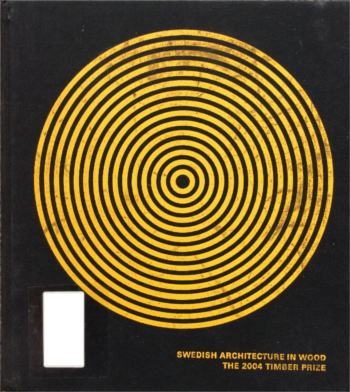Title: Swedish Architecture in Wood: The 2004 Timber Prize
Author: Compiled by the Swedish Forest Industries Federation and the respective architects of the structures
Editor: Marie Ånsell, Andreas Falk and Gabrielle Waldén
Photographer/s: Åke E:son Lindman
Designer: Jesper Skoog/Gabor Palotai Design
Translation: Roger Tanner (English)
ISBN: 91-85213-08-X
Size: 212mm by 236mm, 176p.
Publisher: Arvinius Förlag
Publisher www: www.arvinius.se
Published in: 2004

The Scandinavian countries have a strong tradition of building in wood, one that has outlasted the modern age of steel and concrete. One of the ways in which the government of Sweden encourages more building in wood is in Sweden’s Timber Prize, an annual competition open solely to designs that showcase excellence in wood use and that rewards buildings that incorporate wood holistically with other materials if they are used. Swedish Architecture in Wood: The 2004 Timber Prize details ten of the most impressive entrants from the 2004 prize.
The book has a strong design aesthetic, with black and white title pages dividing up the included structures. The focus on them is pictorial, with full- or double-page size photos taking up most of the book. Each case study also looks at blueprints and diagrams of the building structures, particularly where wood is used structurally. Written passages are less important in Swedish Architecture in Wood, with each inclusion having a single page of text describing the structure. The font size is pretty large, which is a little off-putting, and thus the amount of information contained in the writing is less than could have been fit there. That being said, the language is concise and professional, so the lower quantity of information is made up for by its quality.
The winner of the 2004 Swedish Timber Prize was the Universeum in Gothenburg. The book devotes a larger portion of its contents to this structure over the other inclusions, for obvious reasons. The Universeum is a phenomenal structure; multiple spaces interweave behind its glass-and-wood façade with a large portion of the wooden structure visible from the interior. The building also houses a sizable quantity of living trees through two of the large interior spaces, in which there are several suspended screens to maintain acceptable levels of humidity. The building has, since its construction, received immense acclaim from both critical and public sectors.
While the Universeum was the eventual awarded winner, the other included structures are worthy of examination and showcase the level of quality that the prize attracts in its entrants. Most of the other inclusions are not the size of the Universeum and are evenly divided between houses and commercial/public buildings. The Villa Karlsson (81) in Tidö-Lindö shows how wood charms and entices as a building material, using vertical timber cladding painted a typical Swedish red and a number of skylights piercing the traditional saddle roof. In a more subdued manner, the Studios at the Nordic Watercolour Museum (33) in Skärhamn have a muted colour scheme that blends in with the often fog-shrouded waterfront that contrasts with the warm wood-lined interiors.
Swedish Architecture in Wood contains a fairly wide variety of buildings that, as the most impressive entrants in the 2004 Timber Prize, showcase the past quality of timber design in Sweden, a quality that continues to this day. The competition is also still in existence, with books released for each year. The entrants in 2004 are particularly impressive, leading to a highly interesting book and a window into the past design landscape of Sweden.
